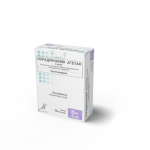Enoxaparin sodium
АмпулыA medicinal product for the prevention of venous thrombosis and thromboembolism.

Important
Indications
Enoxaparin sodium is used in adult patients for the prevention and treatment of the following conditions:
• Prophylaxis of venous thrombosis and embolism (blockage of venous vessels by blood clots) during surgical interventions in moderate and high-risk patients (with a predisposition to venous thrombosis), especially in orthopaedic and general surgical interventions, including oncological interventions.
• Prevention of venous thrombosis and embolism in patients on bed rest due to acute therapeutic diseases, including acute heart failure and decompensation of chronic heart failure, respiratory failure, as well as in severe infections and rheumatic diseases at increased risk of venous thrombosis.
• Treatment of deep vein thrombosis with pulmonary embolism (blockage of the pulmonary artery by a detached thrombus) or without pulmonary embolism, except for cases of pulmonary embolism requiring thrombolytic therapy (dissolution of the thrombus) or surgical intervention.
• Prevention of thrombosis in the haemodialysis machine during a haemodialysis session (a procedure for purifying blood outside the human body using an "artificial kidney" machine).
• Treatment of acute coronary syndrome (a condition associated with a sudden decrease in blood flow to the heart due to impaired patency of the heart vessels):
- Treatment of unstable angina pectoris and myocardial infarction without ST-segment elevation (a change on the electrocardiogram) in combination with the use of acetylsalicylic acid;
- Treatment of acute myocardial infarction with ST-segment elevation in patients subject to drug treatment or subsequent percutaneous coronary intervention (surgical treatment to restore patency of the heart vessels).
If there is no improvement or if you feel worsening, you should contact your doctor.
Contraindications
Do not use the drug Enoxaparin sodium:
• If you are allergic to enoxaparin sodium, heparin or its derivatives (including other low molecular weight heparins) or to any of the excipients listed in section 6 of the leaflet;
• If you have a bleeding disorder or conditions and diseases for which there is a high risk of bleeding, including:
- A recent haemorrhagic stroke (brain haemorrhage);
- acute gastrointestinal (GI) ulcer - oesophagus, stomach or intestine;
- malignant neoplasms with a high risk of haemorrhage have been detected,
- recent brain or spinal cord surgery, eye surgery;
- oesophageal varices, other vascular anomalies (especially in the spinal cord and brain) - arteriovenous malformations (abnormal connection between veins and arteries), vascular aneurysms;
• in the next 24 hours before spinal, epidural or local-regional anaesthesia;
• if you have had immune-mediated heparin-induced thrombocytopenia (decreased platelet count due to the body's formation of antibodies against its own platelets) less than 100 days ago or have antiplatelet antibodies in your blood.
Usage
Always use the product in full compliance with the recommendations of your doctor. If in doubt, consult your doctor.
Recommended dose
Prevention of venous thrombosis and embolism during surgical interventions in moderate and high-risk patients
If you are at moderate risk of developing thrombosis and embolism (for example, during abdominal surgery), you will receive Enoxaparin sodium at a dose of 20 mg (milligrams) once daily by subcutaneous injection. You will receive your first injection 2 hours before surgery.
If you have a high risk of thrombosis and embolism (e.g. orthopaedic surgery, oncological surgery, if you have a congenital or acquired predisposition to blood clots, malignancy, obesity, pregnancy, varicose veins of the lower limbs, if you have had venous thrombosis before, if you need to stay in bed for more than 3 days), you will receive Enoxaparin sodium at a dose of 40 mg once a day subcutaneously. The first injection will be given 12 hours before the surgical intervention. If earlier preoperative prophylaxis is necessary (e.g. in case of delayed orthopaedic surgery), the last injection of the drug will be given 12 hours before the surgery and the next one 12 hours after the surgery. The average duration of treatment is 7-10 days. If necessary, the therapy will be continued as long as you remain at risk of thrombosis and embolism and until you become an outpatient. If you have had major orthopaedic surgery, your doctor may prescribe further treatment with Enoxaparin sodium at a dose of 40 mg once daily for 5 weeks after initial therapy. Patients with a high risk of venous thromboembolism, who have undergone surgery, abdominal and pelvic surgery due to oncological disease, the drug may be continued at a dose of 40 mg once a day for 4 weeks.
Have questions? Contact Us
Has contraindications. Needs specialist overview.







